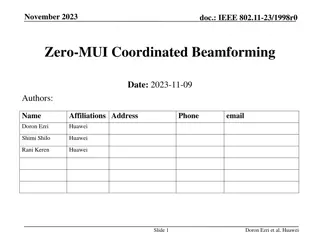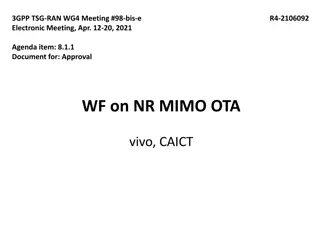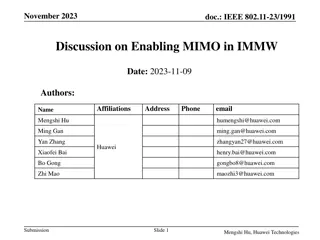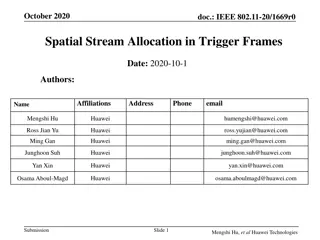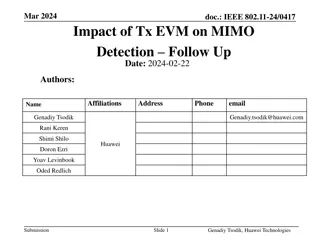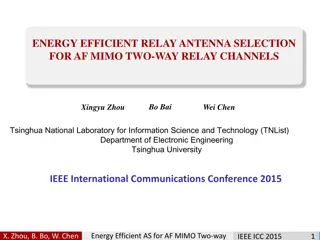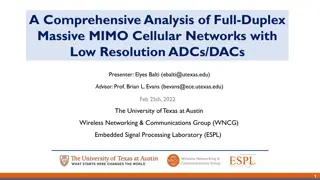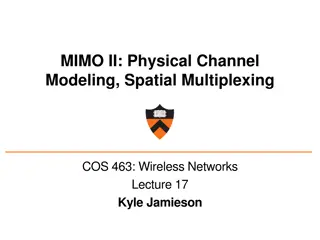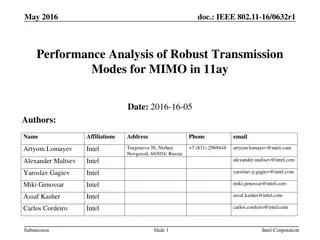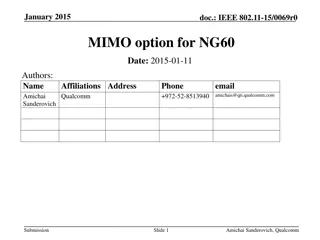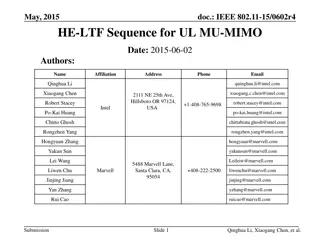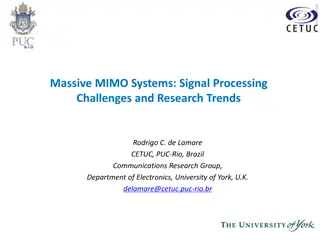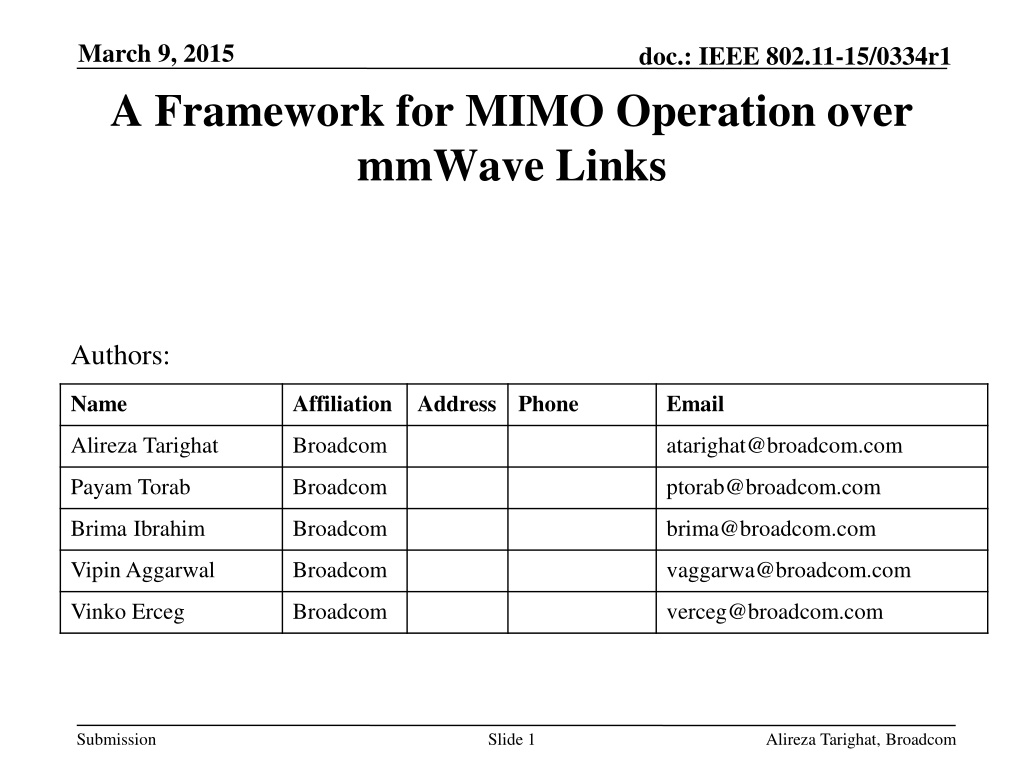
Framework for MIMO Operation over mmWave Links
Explore the framework for MIMO operation over mmWave links, focusing on scenarios, beamforming, diversity, and the impact of phase noise. Discusses the applicability of MIMO in a 2x2 mmWave system and SVD multiplexing in LOS MIMO channels.
Download Presentation

Please find below an Image/Link to download the presentation.
The content on the website is provided AS IS for your information and personal use only. It may not be sold, licensed, or shared on other websites without obtaining consent from the author. If you encounter any issues during the download, it is possible that the publisher has removed the file from their server.
You are allowed to download the files provided on this website for personal or commercial use, subject to the condition that they are used lawfully. All files are the property of their respective owners.
The content on the website is provided AS IS for your information and personal use only. It may not be sold, licensed, or shared on other websites without obtaining consent from the author.
E N D
Presentation Transcript
March 9, 2015 doc.: IEEE 802.11-15/0334r1 A Framework for MIMO Operation over mmWave Links Authors: Name Affiliation Address Phone Email Alireza Tarighat Broadcom atarighat@broadcom.com Payam Torab Broadcom ptorab@broadcom.com Brima Ibrahim Broadcom brima@broadcom.com Vipin Aggarwal Broadcom vaggarwa@broadcom.com Vinko Erceg Broadcom verceg@broadcom.com Submission Slide 1 Alireza Tarighat, Broadcom
March 9, 2015 doc.: IEEE 802.11-15/0334r1 Contents mmWave MIMO for NG60 Possible MIMO scenarios SVD multiplexing Multi-array beamforming Spatial aggregation Multi-array diversity Impact of phase noise on SVD multiplexing Conclusions Submission Slide 2 Alireza Tarighat, Broadcom
March 9, 2015 doc.: IEEE 802.11-15/0334r1 Applicability of MIMO to mmWave A 2x2 mmWave system deploys 2 TX arrays and 2 RX arrays. Each array may have N elements, but only two data feeds are available. Each array has a programmable phase shifter that can be leveraged to change the MIMO channel seen by the 2x2 system. A major difference with sub-5GHz systems where omni elements are used. Additional knob available through changing array patterns. RF TRX RF TRX 2x2 MIMO 2x2 MIMO RF TRX RF TRX Submission Slide 3 Alireza Tarighat, Broadcom
March 9, 2015 doc.: IEEE 802.11-15/0334r1 Scenario 1: SVD Multiplexing (SM) Form a 2x2 MIMO System Apply SVD with/without waterfilling Due to narrow beam patterns, the propagation will look like a LOS (AWGN) MIMO channel. Can we expect a significant multiplexing gain in LOS (AWGN) MIMO channels? 2-stream Encoder SVD De-Multiplexing SVD Multiplexing RF TRX RF TRX 2-stream Decoder RF TRX RF TRX Submission Slide 4 Alireza Tarighat, Broadcom
March 9, 2015 doc.: IEEE 802.11-15/0334r1 Scenario 1: SVD Multiplexing (SM) Two example usage cases High cross-interference between the streams (LOS MIMO & AWGN MIMO scenarios) These two scenarios can be common in outdoor deployments. Device Device LOS Device Blocker Device Reflector Reflector Submission Slide 5 Alireza Tarighat, Broadcom
March 9, 2015 doc.: IEEE 802.11-15/0334r1 Scenario 1: SVD Multiplexing (SM) SISO Capacity ?????(?)= log(1 +? y1 x1 1 ?) TX Power: P Line-of-Sight MIMO Capacity ??:?? ??=????? det (? +???? y1 ?????= max ) 1???11 ????12 x1 ? 1 + ?2 ? ??(+?11 ?21)+ ??(+?12 ?22) 1 + ?2 ?? = ? ??( ?11+?21)+ ??( ?12+?22) ????21 y2 x2 Above ????? can be realized through SVD when CSI is available at TX. 1???22 Submission Slide 6 Alireza Tarighat, Broadcom
March 9, 2015 doc.: IEEE 802.11-15/0334r1 Scenario 1: SVD Multiplexing (SM) MIMO capacity will depend on the following value: Phase delta (function of distance): ??= +?11 ?12+ ?22 ?21 MIMO capacity without waterfilling: 2 2 1 +? 2 ?? ?1 + k2 ?????= ??? 1 + cos(+?11 ?12+ ?22 ?21) ? MIMO capacity with waterfilling ??? 1 +?? Where ??=2? ???, and ?? are the eigenvalues of ?? ?????= ??:sum ?? 2? max 2??? ? Submission Slide 7 Alireza Tarighat, Broadcom
March 9, 2015 doc.: IEEE 802.11-15/0334r1 MIMO Capacity vs Phase Delta ?? P/N=15dB cross gain(k)=0dB 13 MIMO Capacity (1P per TX power) 12 11 Capacity (b/s/Hz) 10 9 8 7 6 0 20 40 60 80 100 120 140 160 180 Phi Delta (deg) Submission Slide 8 Alireza Tarighat, Broadcom
March 9, 2015 doc.: IEEE 802.11-15/0334r1 Scenario 1: SVD Multiplexing (SM) Phase delta=180deg (maximizes capacity) K=0dB 20 phase delta=180, cross gain(k)=0dB SISO Capacity (1P TX power) MIMO Capacity (2P total TX power) MIMO Capacity w/waterfilling (2P total TX power) 18 16 14 Capacity (b/s/Hz) 12 10 8 6 4 2 0 -5 0 5 10 15 20 25 Single Link SNR (dB) Submission Slide 9 Alireza Tarighat, Broadcom
March 9, 2015 doc.: IEEE 802.11-15/0334r1 Scenario 1: SVD Multiplexing (SM) Phase delta=0deg (minimizes capacity) K=0dB 12 phase delta=0, cross gain(k)=0dB SISO Capacity (1P TX power) MIMO Capacity (2P total TX power) MIMO Capacity w/waterfilling (2P total TX power) 10 8 Capacity (b/s/Hz) 6 4 2 0 -5 0 5 10 15 20 25 Single Link SNR (dB) Submission Slide 10 Alireza Tarighat, Broadcom
March 9, 2015 doc.: IEEE 802.11-15/0334r1 Scenario 1: SVD Multiplexing (SM) TX spacing=0.15m, RX spacing=0.2m, cross gain(k)=0dB TX arrays spacing=15cm RX arrays spacing=20cm K=0dB Short range (small # of elements) 18 SISO Capacity (1P TX power) MIMO Capacity w/waterfilling (2P total TX power) 16 14 12 Capacity (b/s/Hz) 10 8 6 4 2 0 0 0.5 1 1.5 2 2.5 3 3.5 4 4.5 5 Range (m) Submission Slide 11 Alireza Tarighat, Broadcom
March 9, 2015 doc.: IEEE 802.11-15/0334r1 Scenario 1: SVD Multiplexing (SM) TX spacing=0.2m, RX spacing=0.3m, cross gain(k)=0dB TX arrays spacing=15cm RX arrays spacing=20cm K=0dB Long range (high # of elements) 20 SISO Capacity (1P TX power) MIMO Capacity w/waterfilling (2P total TX power) 18 16 14 Capacity (b/s/Hz) 12 10 8 6 4 2 0 0 10 20 30 40 50 60 70 80 90 100 Range (m) Submission Slide 12 Alireza Tarighat, Broadcom
March 9, 2015 doc.: IEEE 802.11-15/0334r1 Scenario 2: Multi-Array Beamforming (MAB) Form a larger single array by phase-aligning the two arrays Transport a single stream at higher SNR 2 TX arrays and 2 RX arrays: 9dB higher total SNR compared to SISO case RF TRX RF TRX Beamforming Beamforming Multi-Array Multi-Array 1-stream 1-stream Decoder Encoder RF TRX RF TRX Submission Slide 13 Alireza Tarighat, Broadcom
March 9, 2015 doc.: IEEE 802.11-15/0334r1 Scenario 2: Multi-Array Beamforming (MAB) Two example usage cases 9dB SNR gain compared to single array case (6dB from TX and 3dB from RX) At low SNR, scheme 2 outperforms scheme 1 without waterfilling Device Device LOS Device Blocker Device Reflector Submission Slide 14 Alireza Tarighat, Broadcom
March 9, 2015 doc.: IEEE 802.11-15/0334r1 SVD Multiplexing vs MAB Multi-array beamforming (MAB) provides 9dB SNR gain compared to a single array case (6dB from TX and 3dB from RX) At high SNR, SVD-M outperforms MAB in terms of capacity. At low SNR, MAB outperforms SVD-SP w/o waterfilling (with substantial delta) At low SNR, MAB outperforms SVD-SP w waterfilling (but with very marginal delta) Multi-Array Beamforming (MAB) is simple to support from standard perspective (11ad nearly sufficient to support it). It is more of an implementation choice. Submission Slide 15 Alireza Tarighat, Broadcom
March 9, 2015 doc.: IEEE 802.11-15/0334r1 SVD Multiplexing vs MAB SVD-Multiplexing can reach MAB performance at low SNR only with the help of waterfilling relative power in each spatial stream in SM with waterfilling (k=1, snr=10dB) spatial multiplexing (SM) with waterfilling vs. MAB (k=1, SNR=3dB) 1 4.7 Strongest eigen-mode Second eigen-mode SVD-SM w/ waterfilling MAB 0.9 4.6 0.8 4.5 0.7 fraction of total power 2P 4.4 0.6 capacity (b/s/hz) 4.3 0.5 0.4 4.2 0.3 4.1 0.2 4 0.1 3.9 0 0 20 40 60 80 100 120 140 160 180 0 20 40 60 80 100 120 140 160 180 phase delta (deg) phase delta (deg) Submission Slide 16 Alireza Tarighat, Broadcom
March 9, 2015 doc.: IEEE 802.11-15/0334r1 Scenario 3: Spatial Aggregation (SA) SVD can be eliminated if sufficiently separated beams can be identified. Simplified TX and RX implementation May be defined as a baseline MIMO mandatory mode (while making SVD-Multiplexing optional) Optional Interference- RF TRX RF TRX Cancellation 2-stream 2-stream Decoder Encoder RF TRX RF TRX Submission Slide 17 Alireza Tarighat, Broadcom
March 9, 2015 doc.: IEEE 802.11-15/0334r1 Scenario 3: Spatial Aggregation (SA) Example usage case SA is a subset of SVD-Multiplexing Use of interference cancellation in RX side is implementation and vendor choice. Reflector Device Blocker Device Submission Slide 18 Alireza Tarighat, Broadcom
March 9, 2015 doc.: IEEE 802.11-15/0334r1 Scenario 4: Multi-Array Diversity (MAD) Transport the same streams across two arrays. A sub-optimal configuration to MAB when MAB is not applicable. SNR is low for significant gain out of SVD-SM Link reliability/redundancy is a key metric Cross-interference between the multiple beams is relatively high 3dB diversity/energy combining gain compared to a single array case. Spatial Diversity RF TRX RF TRX 1-stream 1-stream Combining Decoder Encoder RF TRX RF TRX Submission Slide 19 Alireza Tarighat, Broadcom
March 9, 2015 doc.: IEEE 802.11-15/0334r1 Scenario 4: Multi-Array Diversity (MAD) Example usage case Simple reliability improvement Energy combining gain Reflector Blocker Device Device Submission Slide 20 Alireza Tarighat, Broadcom
March 9, 2015 doc.: IEEE 802.11-15/0334r1 Summary of MIMO Scenarios Mode Number of data streams (Constellation- Level) True MIMO Coding Improved Merit of Figure Some applicable usages SVD Multiplexing (SM) -Closed Loop using CSI Two Yes Throughput Backhaul capacity, adjacent arrays, high SNR, polarization multiplexing Backhaul range, adjacent arrays, low SNR Multi-Array Beamforming (MAB) Single No SNR Spatial Aggregation (SA) -Open Loop Two No Throughput Indoor/Outdoor, polarization multiplexing when good separation available Multi-Array Diversity (MAD) Single No SNR Indoor, distant arrays Submission Slide 21 Alireza Tarighat, Broadcom
March 9, 2015 doc.: IEEE 802.11-15/0334r1 Phase Noise Impact on SVD Multiplexing Phase noise seen by the multiple streams may only be partially correlated Cases that two different RFIC chips are deployed An SVD-based multiplexing will experience cross-stream interference due to uncorrelated phase noise This effect is not seen in existing MIMO systems (such as 11ac where the same LO is feeding the multiple streams) Simulation scenario: Low-frequency correlated phase noise and high-frequency uncorrelated phase noise Integrated phase noise (uncorrelated portion) of 5 deg (fairly pessimistic) Submission Slide 22 Alireza Tarighat, Broadcom
March 9, 2015 doc.: IEEE 802.11-15/0334r1 Phase Noise Impact on SVD Multiplexing Capacity degradation due to inter-stream interference from uncorr phase noise (5 deg rms) when using SVD based stream separation, SNR=10dB, cross-leakage=0dB Integrated uncorrelated phase noise = 5deg 9 MIMO, no pn, (1P per TX chain) MIMO, with pn (1P per TX chain) SISO, no pn, (1P TX chain) SISO, with pn, (1P TX chain) 8 7 capacity (b/s/hz) 6 5 4 3 0 20 40 60 80 100 120 140 160 180 phase delta (deg) Submission Slide 23 Alireza Tarighat, Broadcom
March 9, 2015 doc.: IEEE 802.11-15/0334r1 Summary All four multi-radio scenarios can be implemented using a common PHY standard framework. Possible standard framework: Ability to generate 2 to 4 independent streams (no cross coding) Enables two modes of operation: transport data streams over the same frequency channel (spatial aggregation) or over different frequency channels (carrier aggregation) Ability to apply some form of SVD coding to generate 2 to 4 coded data streams This waveform generation framework enables following usages: SVD multiplexing (LOS/AWGN MIMO), polarization multiplexing, multi- array beamforming, spatial aggregation, carrier aggregation, multi-array diversity. Same channel Different channels No TX cross-coding Spatial aggregation Carrier aggregation TX cross-coding SVD multiplexing N/A Submission Slide 24 Alireza Tarighat, Broadcom

